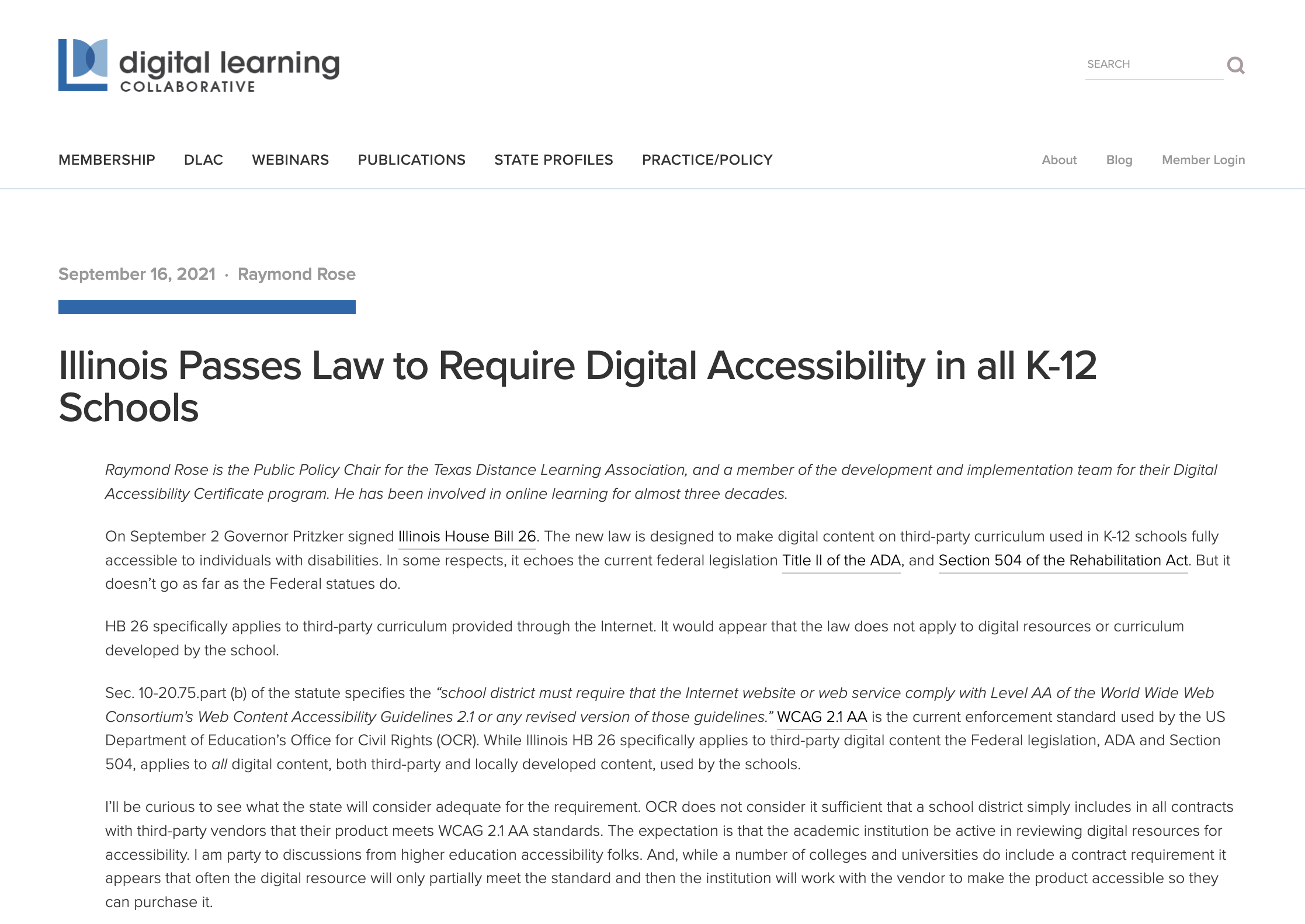New Digital Accessibility Law Improves Education for Millions of Disabled Illinois Students
Aug 05 2022
On Monday August 1st, 2022, Illinois House Bill 26 (HB 26) entered as law in the State of Illinois, details of the bill can be viewed at https://trackbill.com/bill/illinois-house-bill-26-sch-cd-internet-accessibility/1978129/ (opens in a new window).
The law, which was passed late last year, sets out to extend additional civil rights protections to another 2 million students enrolled at schools in the State of Illinois. The new law (Public Act 102-0238) extends digital accessibility safeguards to students enrolled in educational curriculum in the state of Illinois regardless of the institution’s ownership (inclusive of both public and private institutions). The law requires that all institutions comply with a set of standards and provide accessible content to meet said standards for students enrolled in their curriculums.
What does Illinois’ new law do?
HB 26 compels all institutions to update and provide materials relevant to their curriculum in an accessible format to students. The law specifically holds jurisdiction over material offered, transmitted, or disseminated using a digital platform. The contents of the curriculum utilized by the schools on such platforms are compelled to adhere to “Level AA of the World Wide Web Consortium's Web Content Accessibility Guidelines 2.1 or any revised version of those guidelines” regardless of the modem in which they choose to instruct (via physical documents or a platform that is digitally accessed). Illinois School Code (105 ILCS 5/10-20.75) expands the definition of “internet website or web service” used in the context of school curriculum to include third party content provided through the internet. As such, institutions are at greater risk for litigation and assume higher levels of liability for inaccessible content that they provide. Institutions for education consistently administer inaccessible third-party content to students, and often are unaware they are doing so. Administrators (and instructors) unfamiliar with web accessibility guidelines task students to engage with platforms that are utilized and/or contracted by the institution for use in the classroom, all without knowing whether a student can access the information. Such examples include the use web-based virtual learning environments (like Blackboard, Canvas, etc.), the dissemination of articles through portable document formats (PDFs), and the administration of exams through online platforms. 1
Your/Your client institution is in Illinois. What’s your risk?
A substantive component of this law is that it transfers the responsibility for ensuring that the content accessed in a digital format provided to students in the classroom (or materials needed for instruction) is accessible to all students onto the institution. As such, the schools/school districts/institutions assume a higher level of risk than previous academic years. The institution assumes liability for all content required of the students to engage with their curriculum. Such content, as previously mentioned, extends to information/documents utilized in the learning process that aren’t necessarily created by your institution. 2
To ensure that your institution mitigates its level of risk, consider all aspects of your curriculum and asses where the vulnerabilities might be. In assessing the content created by your institution directly, ensure that all documents are accessible to students. In assessing your risk when it comes to third-party content, first determine the accessibility of the content, and consult with counsel as to the proper remediation of inaccessible content. For instances where third-party contracting is involved, the text of your contract will shine a light on the level of risk associated with their use in a curriculum. Whenever possible, seek out indemnities to lower the risk of your entity being sued for inaccessible content created by others.
-
Note: The inclusion of a specific company’s name in this list does not necessarily mean that content on their platforms is inherently inaccessible and should not be read as such. The inclusion of such examples is to engage the reader of this article with widely known platforms utilized by schools in the United States/the State of Illinois. ↩
-
This can include online learning platforms, PDF documents, virtual testing, etc. The law is ambiguous on whether schools would be responsible for providing students with accessible e-textbooks. ↩
Subscribe to AAAtraq and enjoy complete cover and peace of mind
